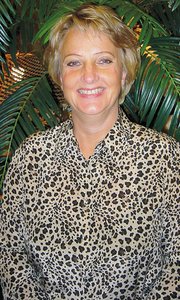Slow Traffic at Mini Gift/Home Market at CMC
The Los Angeles Gift & Home Accessories Market, held at the California Market Center Sept. 21–23, was like a beautifully wrapped present with nothing inside.
Showroom reps and buyers scratched their heads in unison, unable to explain the show’s dismal attendance.
“The ladies I work with have been in this business longer than I have, and they’ve never seen a show as quiet as this,” said Julia Tayrani, showroom manager of Sullivans, a 35-year-old florals-and-gifts wholesaler in suite C998.
After poor August sales, down 70 percent from last year, Tayrani was hoping for better business. “I was hoping people would suddenly realize that the holidays are here and we would see the response,” she said. Instead, she said she wrote just one or two orders per day.
Tracie Van Eimeren of New Creative Enterprises Inc. in suite C851 said that making prearranged appointments was the only way to make the show worthwhile.
The few buyers in attendance were browsing but not placing orders, said David Wernick of David Wernick & Associates, a showroom in suite C1019 that specializes in gifts for the tween market. He characterized today’s buyer as very cautious. “It’s been a couple years since buyers were impulsive,” he said.
On Sunday, the show’s best-attended day, Wernick wrote only $150 in orders, a stark contrast to 10 years ago, when he would do $30,000 in sales on a weekend show day.
Sunday was a busy day, but Monday was “dead,” according to Christian Armbrister, showroom manager at Anne McGilvary & Co., a showroom in suite C1098 that offers retro and pop-culture gifts and furnishings. However, he found that while buyers were selective, they were spending more.
Christina Pfleider, owner of retail store Studio Boutique in Lake Arrowhead, Calif., appreciated having all the showrooms open on the same day and suggested it happen monthly. She also had no hesitation about placing orders. “If I see something I like, I’ll buy it,” she said.
Other buyers wanted to be surprised—and weren’t.
Djojo Prajitno, co-owner of Garden Greeters in Brea, Calif., was eager to place orders but found a dearth of new products.
“It’s all the same stuff,” he said. “I was hoping they would come up with new designs and new products. I don’t want to say it’s disappointing, but what can you do?”
Prajitno speculated that the SARS (severe acute respiratory syndrome) epidemic in Asia earlier this year prevented many U.S. showrooms from purchasing new goods from Asia.
New dates next year?
The September gift market is one of two smaller “mini markets” on the gift-show calendar. The larger shows take place in January and July and coincide with the California Gift Show at the Los Angeles Convention Center.
Buyer attendance at this gift show was flat compared to the interim show held in April, according to Charlie Snyder, interim markets manager for the CMC. Retailers reported that with the major gift industry shows concluding just six weeks ago, they had little need for merchandise, Snyder said. As a result, the CMC is considering scheduling next year’s show for the second week in October.
Next fall’s gift show will also include a space on the 13th floor for temporary exhibitors, in addition to the permanent showrooms, as a result of buyer requests. “Retailers said it gives them more of a reason to shop,” Snyder said.
Crossover traffic growing
Still, there were some bright spots in the otherwise quiet September market.
Some apparel and accessories showrooms said they benefited from spillover traffic from the gift show. About 20 gift-show buyers visited jewelry showroom Le Trend Accessories in suite A1094, according to sales rep Barbara Vandermey. About one-quarter of them placed orders for items such as bracelets and ponchos. “A few of them said, ’It’s mostly home stuff [in the gift showrooms], and we wanted to see accessories,’” she added.
Michael Stern of Michael Stern & Associates is a consultant to the gift retailing industry, which he said is going through tough times.
“Retailers are struggling,” he said. “And when you’re struggling to make sales, you don’t want to buy more merchandise.”
Stern advises his clients to do the opposite: to continuously offer fresh merchandise. “The best retailers doing the best business are combining hard and soft goods because it makes their story more interesting to the consumer,” he said.
Stern planned to recommend that his clients look to the fashion industr y for inspiration.
“Apparel changes all the time,” he said. “So look at fashion for colors. That’s how you get a fresh look—by crossing over.”























